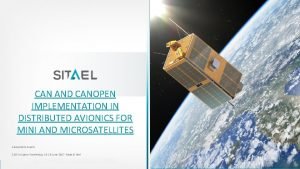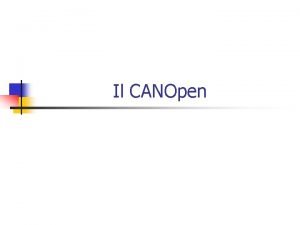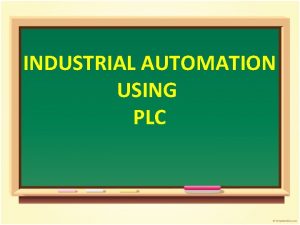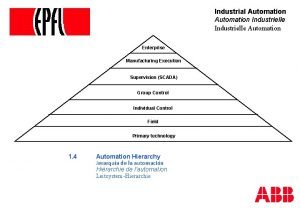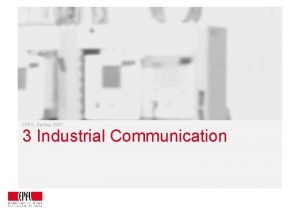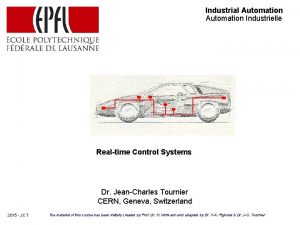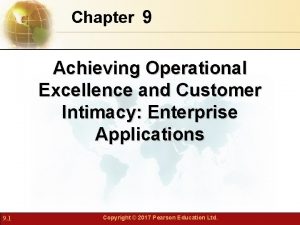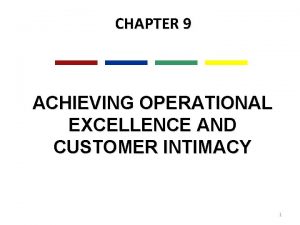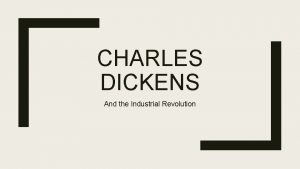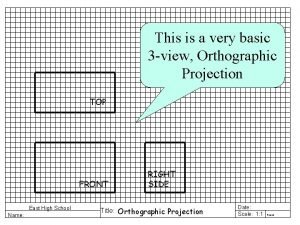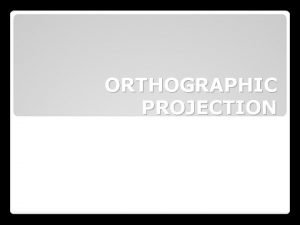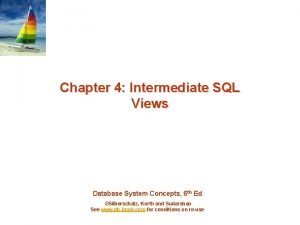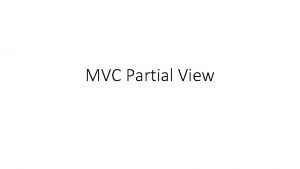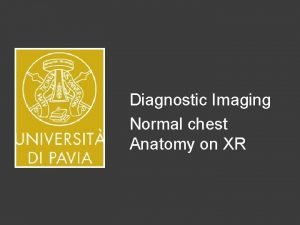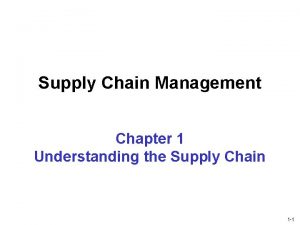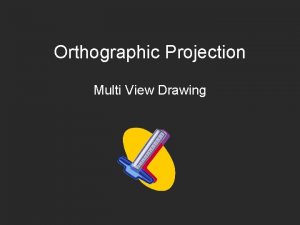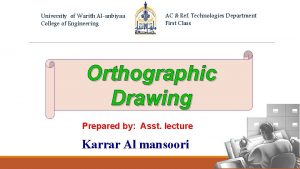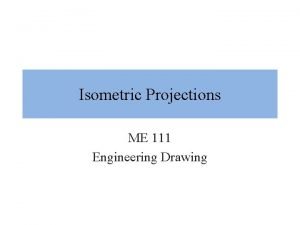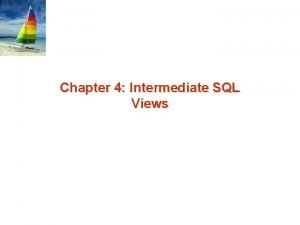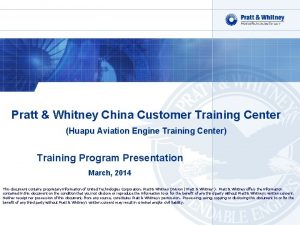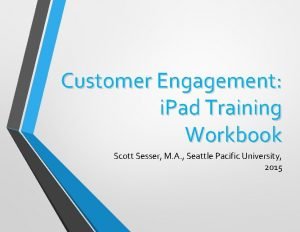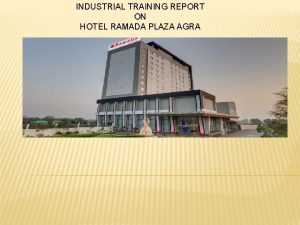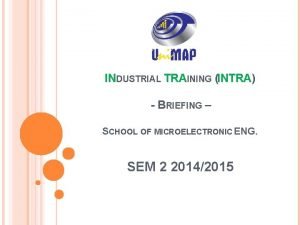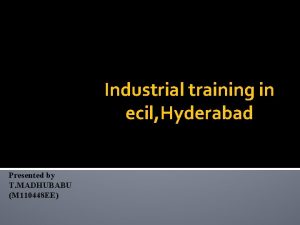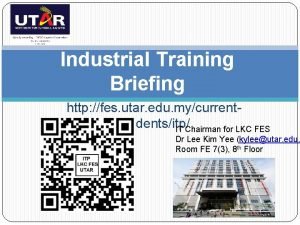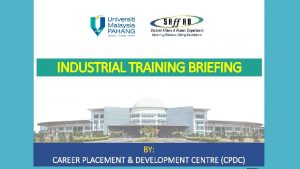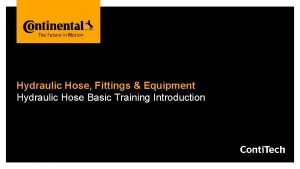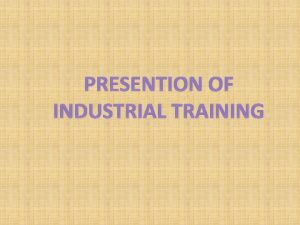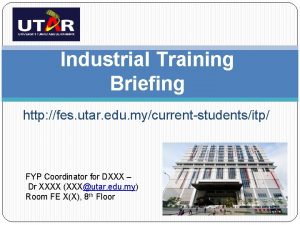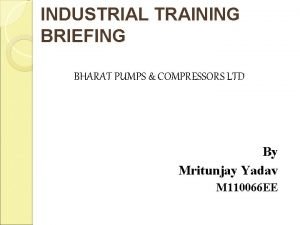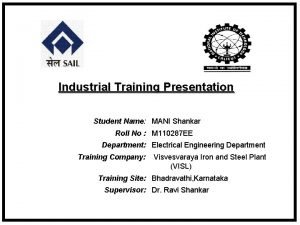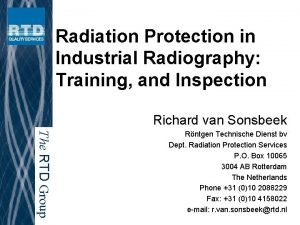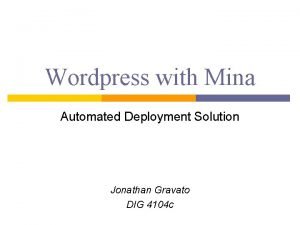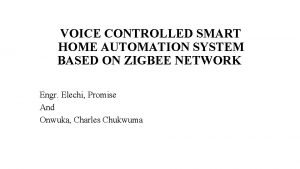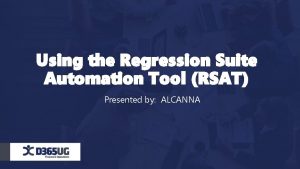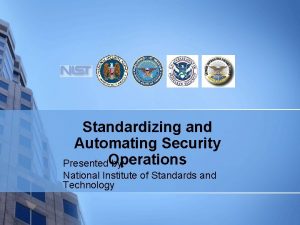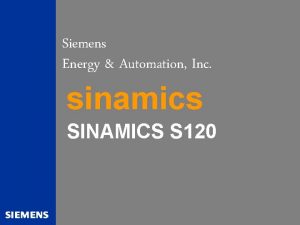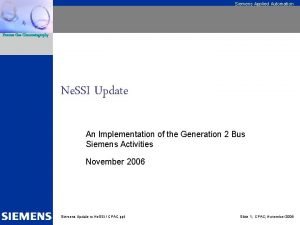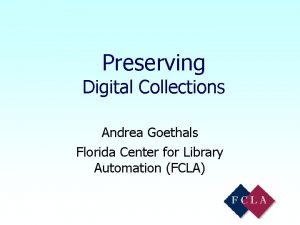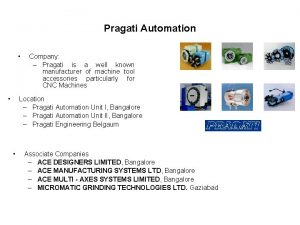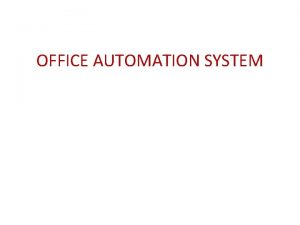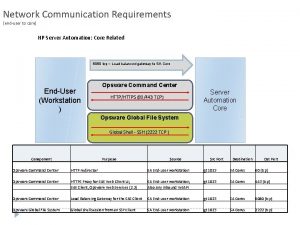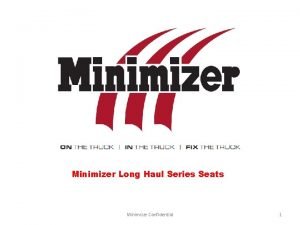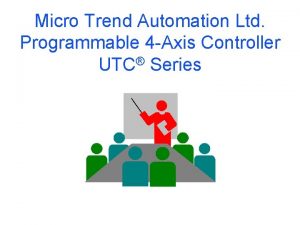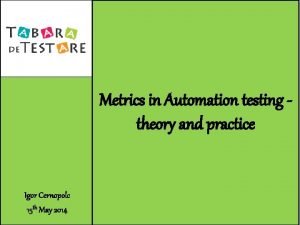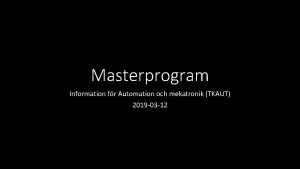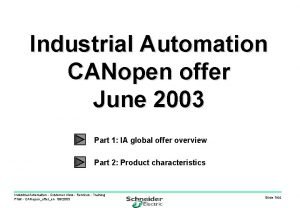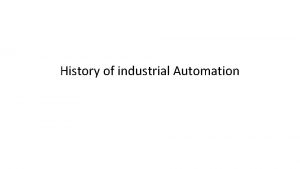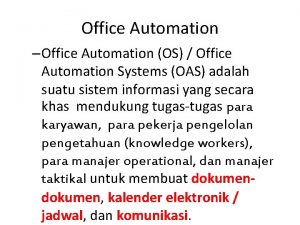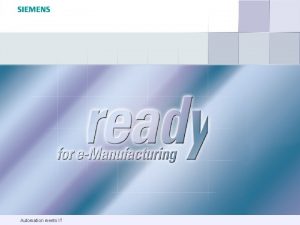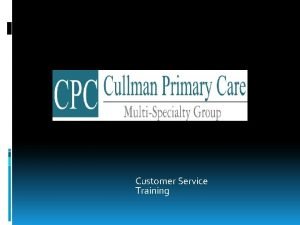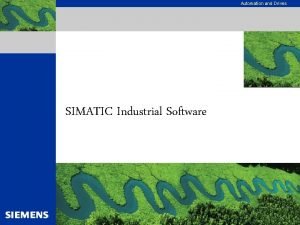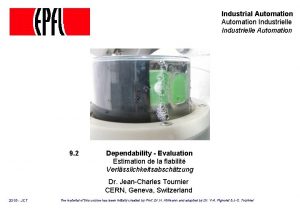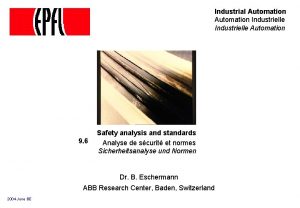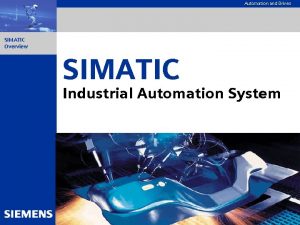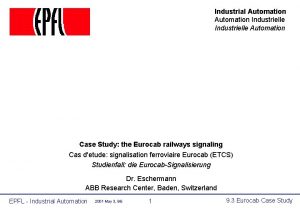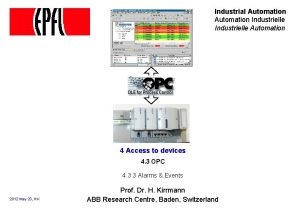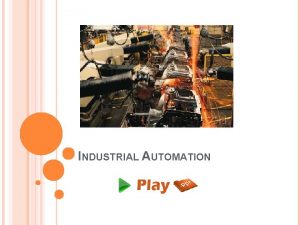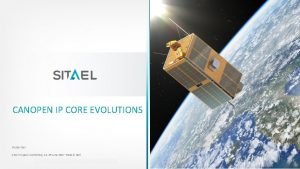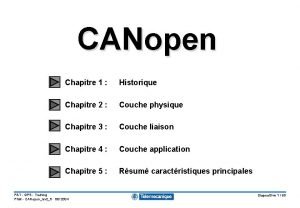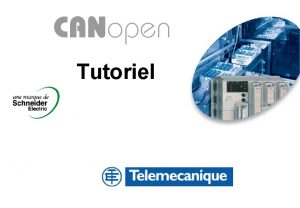CANopen training Industrial Automation Customer View Training Ph



















































































- Slides: 83

CANopen training Industrial Automation - Customer View - Training Ph. W - CANopen_en 02/ 2002 Slide 1

CANopen Industrial Automation - Customer View - Training Ph. W - CANopen_en 02/ 2002 Section 1 : Basic knowledge Section 2 : Application layer Section 3 : Link layer Section 4 : Physical layer Section 5 : Schneider offer overview Section 6 : Diagnostics Slide 2

CANopen Section 1: Basic knowledge Part 1: History Part 2: Main characteristics Industrial Automation - Customer View - Training Ph. W - CANopen_en 02/ 2002 Slide 3

Section 1: Basic knowledge - Part 1: History 1980: The automotive industry indicates a need for low-cost, real-time, highly reliable communication between various on-board electronic subassemblies. 1983: In partnership with several German universities, the German equipment manufacturer Robert BOSCH develops the specifications for the communication protocol CAN = Controller Area Network. 1985: The first CAN integrated circuits are marketed by INTEL. 1986: Initial prototypes presented to the USA at Detroit. 1987: The major silicon manufacturers: Philips, Motorola, National Semiconductors, Texas Instruments, MHS, SIEMENS offer a complete range of drivers and micro-controllers which integrate CAN. Industrial Automation - Customer View - Training Ph. W - CANopen_en 02/ 2002 Slide 4

Section 1: Basic knowledge - Part 1: History 1989: First industrial applications. 1987 to 1991: Establishment of promotional organizations for both automotive (SAE, OSEK), and industrial (CIA = CAN in Automation) applications. 1991: CAN Low Speed (125 kbps/Identifiers coded on 11 bits) becomes standard ISO 11519 -2. 1992: MERCEDES uses a 500 kbps CAN bus to link 5 electronic subassemblies on an S class. 1993: CAN High Speed (1 Mbps/Identifiers on 11 bits) becomes standard ISO 11898 = CAN 2. 0 A. Industrial Automation - Customer View - Training Ph. W - CANopen_en 02/ 2002 Slide 5

Section 1: Basic knowledge - Part 1: History 1995: Amendment to standard ISO 11898 introducing identifiers coded on 29 bits = CAN 2. 0 B. Publication by the Ci. A of communication profile DS-301. 1996: CAN is used on the majority of motor controls in top-of-the-range European cars. 1997: 300 companies are members of the Ci. A. 1998: New set of ISO standards for diagnostics and compliance testing. Industrial Automation - Customer View - Training Ph. W - CANopen_en 02/ 2002 Slide 6

Section 1: Basic knowledge - Part 2: Main characteristics Reference specifications CANopen was built chronologically on the basis of several specifications: • CAN 2. 0 A and B (originating from Robert BOSCH) Defines precisely the link layer and part of the physical layer • CAL = CAN Application Layer (Ci. A): Provides tools for developing an application using CAN without instructions for use + further details on the physical layer • CANopen (Ci. A): Defines which CAL tools to use and how. Ensures interoperability of products by profile descriptions. Industrial Automation - Customer View - Training Ph. W - CANopen_en 02/ 2002 Slide 7

Section 1: Basic knowledge - Part 2: Main characteristics Physical Layer Medium: Shielded twisted pair 2 or 4 -wire (if power supply) Topology: Maximum distance: Bus type With short tap links and end-of-line resistor 1000 m Data rate: 1 Mbps at 25 metres, 10 Kbps at 1000 metres Depends on the length of the bus and the type of cable Max. no. of devices: 128 Industrial Automation - Customer View - Training Ph. W - CANopen_en 02/ 2002 1 master and 127 slaves Slide 8

Section 1: Basic knowledge - Part 2: Main characteristics Link layer Network access method: CSMA/CA Each device can send data as soon as the bus is free. In the event of a collision, a principle of dominant or recessive bits can arbitrate bit by bit in a non-destructive manner. The priority of a message is given by the value of the identifier: the identifier with the lowest value has the highest priority. Communication model: Producer/Consumer An identifier located at the start of the message informs receivers as to the type of data contained in each message, each receiver decides whether or not to consume the data. Max. useful data size: Industrial Automation - Customer View - Training Ph. W - CANopen_en 02/ 2002 8 bytes per frame Slide 9

Section 1: Basic knowledge - Part 2: Main characteristics Link layer Security of transmission: Among the best on industrial local area networks. Numerous signalling and error detection devices ensure excellent security of transmission. Industrial Automation - Customer View - Training Ph. W - CANopen_en 02/ 2002 Slide 10

Section 1: Basic knowledge - Part 2: Main characteristics CANopen application layer A CAL subassembly which defines standardized communication objects and 4 types of service: 1. Network administration: parameter setting, starting, monitoring (masterslaves) 2. Transmission of small amounts of process data (<= 8 bytes) in real time: PDO = Process Data Object (producer-consumer) 3. Transmission of large amounts of parameter-setting data (> 8 bytes) using segmentation without time constraints: SDO = Service Data Object (client-server) 4. Predefined messages for managing synchronizations, time-based references, fatal errors: SFO = Special Function Object Industrial Automation - Customer View - Training Ph. W - CANopen_en 02/ 2002 Slide 11

CANopen Section 2: Application layer Part 1: CANopen basic concepts Part 2: CANopen objects and services Industrial Automation - Customer View - Training Ph. W - CANopen_en 02/ 2002 Slide 12

Section 2: Application layer - Part 1: CANopen basic concepts CANopen is based on CAL Device Profile Ci. A DSP-401 I/O modules Device Profile Ci. A DSP-402 Drives Device Profile Ci. A DSP-404 Ci. A DSP-4 xx Measuring devices Ci. A DS-301 = Communication profile 7 APPLICATION 6 PRESENTATION EMPTY 5 SESSION EMPTY 4 TRANSPORT EMPTY 3 NETWORK EMPTY 2 LINK = LLC + MAC CAN 2. 0 A and B + ISO 11898 1 PHYSICAL Industrial Automation - Customer View - Training Ph. W - CANopen_en 02/ 2002 CAL= CAN Application Layer CAN 2. 0 A and B = ISO 11898 -1 and 2 ISO 11898 + DS-102 Slide 13

Section 2: Application layer - Part 1: CANopen basic concepts CAL = CAN Application Layer was established in 1992 by the CAN in Automation association (Ci. A) in order to be able to develop open CAN systems. CAL provides developers with numerous tools without giving any instructions for use. Historically, this was the first step towards interoperability. . . Industrial Automation - Customer View - Training Ph. W - CANopen_en 02/ 2002 Slide 14

Section 2: Application layer - Part 1: CANopen basic concepts Structure of CAL CMS CAN Message Specification Domains NMT Network Management Events Master Slave LMT Layer Management Variables Master Slave Services DBT Identifier Distributor Master Slave CMS defines standard communication objects and services NMT initializes and supervises the network LMT sets the parameters for the various layers DBT is used to distribute identifiers in real time (little used). Industrial Automation - Customer View - Training Ph. W - CANopen_en 02/ 2002 Slide 15

Section 2: Application layer - Part 1: CANopen basic concepts Breakdown of CAL identifiers = COB - ID Priority High Low Industrial Automation - Customer View - Training Ph. W - CANopen_en 02/ 2002 Slide 16

Section 2: Application layer - Part 1: CANopen basic concepts CANopen application layer CANopen uses a restricted number of tools provided by CAL. CANopen defines for a certain number of industrial devices: what data is sent and how by means of profiles CANopen is based on the concept of the object dictionary: Device Object Dictionary (OD) such as INTERBUS and PROFIBUS. Industrial Automation - Customer View - Training Ph. W - CANopen_en 02/ 2002 Slide 17

Section 2: Application layer - Part 1: CANopen basic concepts CANopen Object Dictionary = OD The CANopen Object Dictionary is an ordered group of objects which can be accessed by a 16 -bit index and if necessary a sub-index coded on 8 bits. Each network node has an OD in the form of an EDS: Electronic Data Sheet ASCII type file. This dictionary contains all the elements which describe the node and its behaviour on the network. Industrial Automation - Customer View - Training Ph. W - CANopen_en 02/ 2002 Slide 18

Section 2: Application layer - Part 1: CANopen basic concepts Structure of the CANopen Object Dictionary Industrial Automation - Customer View - Training Ph. W - CANopen_en 02/ 2002 Slide 19

Section 2: Application layer - Part 1: CANopen basic concepts CANopen profiles CANopen defines 2 types of profile: The DS-301 communication profile: Describes the general structure of the OD and objects found in the "Communication profile area" zone. It applies to all CANopen products. DSP-4 xx device profiles: Describes the various associated standard objects for the various types of product (discrete I/O modules, drives, measuring apparatus). Some objects are compulsory, others are optional, some are read-only, others are read-write. Industrial Automation - Customer View - Training Ph. W - CANopen_en 02/ 2002 Slide 20

Section 2: Application layer - Part 2: CANopen objects and services DS-301 CANopen communication profile The CANopen communication profile defines 4 types of message: - network administration messages - Service Data Objects = SDO - Process Data Objects = PDO - Special Function Objects = SFO Industrial Automation - Customer View - Training Ph. W - CANopen_en 02/ 2002 Slide 21

Section 2: Application layer - Part 2: CANopen objects and services CANopen network administration messages These messages are used to manage the various protocol layers, supervise the complete network and distribute identifiers. They are based on the CAL LMT, NMT and DBT services and protocols. Industrial Automation - Customer View - Training Ph. W - CANopen_en 02/ 2002 Slide 22

Section 2: Application layer - Part 2: CANopen objects and services Service Data Objects = SDO These services are used to transmit large amounts of parameter-setting data without any time restriction. They enable a client device to access the OD object dictionary of a server device in read or write mode. The data can exceed 8 bytes, but in this case a data segmentation system is activated. The result of a read or write operation is confirmed by a response. An SDO requires 2 COB-IDs: one for the request, the other for the response. Industrial Automation - Customer View - Training Ph. W - CANopen_en 02/ 2002 Slide 23

Section 2: Application layer - Part 2: CANopen objects and services Process Data Objects = PDO These services are used to transmit small amounts of process data (<= 8 bytes) in real time. They enable a producer device to make a variable with a maximum size of 64 bits without overhead available to one or more consumers. This service is implemented as an " Event-type CMS object" and therefore is not confirmed. Industrial Automation - Customer View - Training Ph. W - CANopen_en 02/ 2002 Slide 24

Section 2: Application layer - Part 2: CANopen objects and services Description of PDOs Each PDO is described by 2 objects in the OD: PDO Communication Parameter indicates which COB-ID is used, which type of transmission is used, and the value of the inhibit time. PDO Mapping Parameter contains the list of objects in the OD as well as their size. Industrial Automation - Customer View - Training Ph. W - CANopen_en 02/ 2002 Slide 25

Section 2: Application layer - Part 2: CANopen objects and services PDO transmission modes Synchronous: by receiving a SYNC object Acyclic: - transmission is pre-triggered by a "Remote Transmission request" - transmission is pre-triggered by the occurrence of a "Specific event" object in the device profile Cyclic: - transmission is triggered periodically after each 1, 2 or up to 240 SYNC objects Asynchronous: - transmission is triggered by a "Remote Transmission request" - transmission is pre-triggered by the occurrence of a "Specific event" object in the device profile Industrial Automation - Customer View - Training Ph. W - CANopen_en 02/ 2002 Slide 26

Section 2: Application layer - Part 2: CANopen objects and services Special Function Objects = SFO SYNC = Synchronization Object: These objects are used to synchronize the acquisition of inputs or updating of outputs (axis control for example). The "SYNC master" sends the SYNC message at a period (communication cycle period) fixed at the time of configuration. Industrial Automation - Customer View - Training Ph. W - CANopen_en 02/ 2002 Slide 27

Section 2: Application layer - Part 2: CANopen objects and services Special Function Objects = SFO Time Stamp Object: The Time-Stamp object provides a time reference common to all devices. This time is coded on 6 bytes and represents an absolute time in ms from 1 st January 1984. Industrial Automation - Customer View - Training Ph. W - CANopen_en 02/ 2002 Slide 28

Section 2: Application layer - Part 2: CANopen objects and services Special Function Objects = SFO EMCY Object: EMCY objects are triggered when an internal fault occurs in the device (current, voltage, temperature, communication, etc). Industrial Automation - Customer View - Training Ph. W - CANopen_en 02/ 2002 Slide 29

Section 2: Application layer - Part 2: CANopen objects and services Special Function Objects = SFO Node guard Object: The NMT master monitors the status of slaves connected to the network by periodically sending a Node guard object remote frame to each slave. Each slave answers immediately on reception. Slaves have the option of monitoring the NMT master: Life guarding. Life Time = Guard Time x Life Time Factor If a slave receives no polling for a period equal to the Life Time, it generates a "Life guarding" event, goes into communication fault mode and sends an EMCY object. Industrial Automation - Customer View - Training Ph. W - CANopen_en 02/ 2002 Slide 30

Section 2: Application layer - Part 2: CANopen objects and services Network status diagram Transitions performed by the NMT master: authorized: 1: Start_Remote_Node 2: Stop_Remote_Node 3: Enter_Pre-Operational_State 4: Reset_Node 5: Reset_Communication 6: Node initialization complete Industrial Automation - Customer View - Training Ph. W - CANopen_en 02/ 2002 Types of communication object a. NMT b. Node Guard c. SDO d. EMCY e. PDO. Slide 31

Section 2: Application layer - Part 2: CANopen objects and services Allocation of default identifiers With the aim of reducing the network configuration phase a compulsory system for allocating default identifiers has been defined. This allocation occurs in the "Pre operational" state just after the initialization phase. It is based on dividing the COB-ID identifier into 2 parts: 10 9 8 7 Function Code 6 5 4 3 2 1 0 Node ID Function code is used to code 2 PDOs in reception mode, 2 PDOs in transmission mode, 1 SDO, 1 EMCY object, 1 Node Guarding Identifier, 1 SYNC object, 1 Time Stamp object and 1 node guarding. Node ID corresponds to the product address coded by DIP switches, for example. Industrial Automation - Customer View - Training Ph. W - CANopen_en 02/ 2002 Slide 32

Section 2: Application layer - Part 2: CANopen objects and services Allocation of default identifiers Industrial Automation - Customer View - Training Ph. W - CANopen_en 02/ 2002 Slide 33

CANopen Section 3: Link layer Part 1: Frame format Part 2: Exchange protection Industrial Automation - Customer View - Training Ph. W - CANopen_en 02/ 2002 Slide 34

Section 3: Link layer - Part 1: Frame format CAN 2. 0. A and CAN 2. 0. B The CAN V 2. 0 specification consists of 2 parts: CAN 2. 0. A and CAN 2. 0. B. CAN 2. 0. A corresponds to the standard frame format with an identifier coded on 11 bits. It is used by CANopen and most of the application layers. CAN 2. 0. B corresponds to the extended frame format with an identifier coded on 29 bits. It is very rarely used. Industrial Automation - Customer View - Training Ph. W - CANopen_en 02/ 2002 Slide 35

Section 3: Link layer - Part 1: Frame format Structure of the CAN 2. 0. A frame Arbitration field 1 11 Start of frame (SOF) Identifier Frame size without bit stuffing: 47 to 111 bits 1 6 RTR Remote Transmission Request bit Control field: compatibility and length Industrial Automation - Customer View - Training Ph. W - CANopen_en 02/ 2002 0 to 64 Data field 15 111 7 CRC ACK delimit. CRC sequence ACK slot End of frame (EOF) Slide 36

Section 3: Link layer - Part 1: Frame format Structure of the CAN 2. 0. B frame Arbitration field 1 11 11 Frame size without bit stuffing: 67 to 131 bits 18 SRR 1 6 RTR Remote Transmission Request bit Start of frame (SOF) 0 to 64 Data field 15 111 7 CRC ACK delimit. IDE Identifier Industrial Automation - Customer View - Training Ph. W - CANopen_en 02/ 2002 Control field: compatibility and length CRC sequence ACK slot End of frame (EOF) Slide 37

Section 3: Link layer - Part 1: Frame format Compatibility between CAN 2. 0. A and CAN 2. 0. B Upward compatibility applies. 3 types of product have been defined: CAN 2. 0. A: these products prohibit exchanges of CAN 2. 0. B frames since they systematically destroy them. Passive CAN 2. 0. B: these products ignore CAN 2. 0. B frames without destroying them. They allow both exchange formats but only process frames in CAN 2. 0. A format. CAN 2. 0. B: these products are capable of exchanges in both formats. Industrial Automation - Customer View - Training Ph. W - CANopen_en 02/ 2002 Slide 38

Section 3: Link layer - Part 1: Frame format The 4 types of CAN frame Data Frame: these frames transport data from a producer to consumers without any guarantee that it will be processed. Remote Frame: these request frames are sent by a client to a server to request transmission of a data frame (the identifier will have the same value as that of the request). Error Frame: these frames are transmitted when a station detects the presence of errors on the bus. Overload Frame: these frames are sent to ask for an additional time lapse between successive frames (data or request). Industrial Automation - Customer View - Training Ph. W - CANopen_en 02/ 2002 Slide 39

Section 3: Link layer - Part 1: Frame format CAN V 2. 0 A Data Frame Data frame SOF IDENT 1 D 11 X RTR 1 D CTR DATA CRC ACK EOF 6 X 0 to 64 X 5 X+1 R 1 X+1 R 7 R Interframe 3 R CAN V 2. 0 A Remote Frame Request frame SOF IDENT RTR CTR DATA CRC ACK EOF 1 D 11 X 1 R 6 X 0 to 64 X 5 X+1 R 1 X+1 R 7 R Interframe 3 R If a request frame is repeated, the response to this request takes priority. Industrial Automation - Customer View - Training Ph. W - CANopen_en 02/ 2002 Slide 40

Section 3: Link layer - Part 1: Frame format Error Frame Error detected Frame being broadcast ERROR FLAG ERROR DELIMITER ACTIVE ERROR FLAG: 6 D PASSIVE ERROR FLAG: 6 R 8 R Overload Frame EOF or ERROR DELIMITER Previous frame OVERLOAD FLAG 6 D Industrial Automation - Customer View - Training Ph. W - CANopen_en 02/ 2002 OVERLOAD DELIMITER 8 R Slide 41

Section 3: Link layer - Part 2: Exchange protection Protection mechanisms At bit level: when 5 identical bits are transmitted, an additional "stuffing" bit with the opposite value is introduced intentionally. This bit is tested and eliminated by the receiver. At frame structure level, the delimiters CRC Delimiter, ACK Delimiter, End of Frame, Error Delimiter, Overload Delimiter are integrated to enable the structure to be checked. At content validity level: a CRC sequence enables receivers to check the consistency of the data received. ACK slot: this window enables the sender to know that his message has been received correctly by at least one station (dominant bit). Industrial Automation - Customer View - Training Ph. W - CANopen_en 02/ 2002 Slide 42

Section 3: Link layer - Part 2: Exchange protection Error counters Each node must always contain two counters: TEC Transmit Error Counter and REC Receive Error Counter. These counters are incremented and decremented using a sophisticated weighting mechanism etched in the silicon. Depending on the value of these counters, the node will be in one of the following 3 states: Active errors Passive errors Bus OFF (sending driver disconnected from the bus). Industrial Automation - Customer View - Training Ph. W - CANopen_en 02/ 2002 Slide 43

Section 3: Link layer - Part 2: Exchange protection Counter value/node status Reset and configuration Active errors REC > 127 or TEC > 127 REC < 128 and TEC < 128 Passive errors 128 occurrences of 11 consecutive recessive bits (end of frames without errors) TEC > 255 Bus OFF Industrial Automation - Customer View - Training Ph. W - CANopen_en 02/ 2002 Slide 44

Section 3: Link layer - Part 2: Exchange protection Behaviour in the event of detection of a communication error Active error status: On detection of the fault, the node sends an Error Frame with an ACTIVE ERROR FLAG field. The 6 dominant bits sent which contravene the stuffing bit law cause a chain reaction in the other nodes which destroys the active frame. Passive error status: On detection of the fault, the node sends an Error Frame with a PASSIVE ERROR FLAG field. The recessive bits sent have no effect on the frame currently being sent. Bus OFF status: The node is disconnected and monitors the bus. Industrial Automation - Customer View - Training Ph. W - CANopen_en 02/ 2002 Slide 45

CANopen Section 4: Physical layer Part 1: Network characteristics Part 2: Recommended connections Industrial Automation - Customer View - Training Ph. W - CANopen_en 02/ 2002 Slide 46

Section 4: Physical layer - Part 1: Network characteristics CANopen physical layer Device Profile Ci. A DSP-401 I/O modules Device Profile Ci. A DSP-402 Drives Device Profile Ci. A DSP-404 Ci. A DSP-4 xx Measuring devices Ci. A DS-301 = Communication profile 7 APPLICATION 6 PRESENTATION EMPTY 5 SESSION EMPTY 4 TRANSPORT EMPTY 3 NETWORK EMPTY 2 LINK = LLC + MAC CAN 2. 0 A and B + ISO 11898 1 PHYSICAL Industrial Automation - Customer View - Training Ph. W - CANopen_en 02/ 2002 CAL= CAN Application Layer CAN 2. 0 A and B + ISO 11898 + DS-102 + DRP-301 -1 Slide 47

Section 4: Physical layer - Part 1: Network characteristics Description of the network Twisted differential pair: 1 pair if CAN-H/CAN-L 2 pairs if CAN-H/CAN-L + p. supply Characteristic line impedance: 120 ohms nominal Line terminators: 120 ohms at each end Wire resistance: 70 milli-ohms/metre nominal Propagation time: 5 ns/metre nominal Topology: Bus type with the shortest possible tap links Industrial Automation - Customer View - Training Ph. W - CANopen_en 02/ 2002 Slide 48

Section 4: Physical layer - Part 1: Network characteristics Electrical levels Voltage (V) 5 CAN_H 3. 5 2. 5 CAN_L 1. 5 Recessive Dominant Recessive status: Dominant status: VCAN_H - VCAN_L = 0 V (-0. 5 V to + 50 m. V) VCAN_H - VCAN_L = 2 V (1. 5 V to 3 V) Tx output current: Protection: Higher than 25 m. A Against short-circuits Industrial Automation - Customer View - Training Ph. W - CANopen_en 02/ 2002 Time Slide 49

Section 4: Physical layer - Part 1: Network characteristics Data rate - bus length - cable cross-section for 32 slaves maximum Industrial Automation - Customer View - Training Ph. W - CANopen_en 02/ 2002 Slide 50

Section 4: Physical layer - Part 1: Network characteristics Data rate - bus length - cable cross-section for 100 slaves maximum Industrial Automation - Customer View - Training Ph. W - CANopen_en 02/ 2002 Slide 51

Section 4: Physical layer - Part 2: Recommended connections In its recommendation DR-303 -1, the Ci. A provides a list of suitable connectors classified into 3 categories with their pin signal description. General use 9 -pin SUB D connector DIN 41652, multi-pole connector (ribbon cable to 9 -pin SUB-D), RJ 10 and RJ 45 Industrial use 5 -pin Mini Style, 5 -pin Micro Style, Open Style Special use 7 -pin round connector, 8 -pin round connector, 9 -pin round connector, 12 -pin round connector, Hand Brid Harting. Industrial Automation - Customer View - Training Ph. W - CANopen_en 02/ 2002 Slide 52

Section 4: Physical layer - Part 2: Recommended connections 9 -pin SUB D connector DIN 41652 Male product end Pin Signal Description: 1: 2: 3: 4: 5: 6: 7: 8: 9: Industrial Automation - Customer View - Training Ph. W - CANopen_en 02/ 2002 Reserved CAN_L = CAN_L bus line dominant low CAN_GND = CAN Ground Reserved (CAN_SHLD) Optional CAN Shield (GND) Optional Ground CAN_H = CAN_H bus line dominant high Reserved (CAN_V+) Optional CAN external positive supply Slide 53

Section 4: Physical layer - Part 2: Recommended connections RJ 45 connector Pin Signal Description 1: CAN_H = CAN_H bus line (dominant high) 2: CAN_L = CAN_L bus line (dominant low) 3: CAN_GND = Ground/0 V/V 4: Reserved 5: Reserved 6: (CAN_SHLD) = Optional CAN Shield 7: CAN_GND = Ground/0 V/V 8 (CAN_V+) = Optional CAN external positive supply Industrial Automation - Customer View - Training Ph. W - CANopen_en 02/ 2002 Slide 54

Section 4: Physical layer - Part 2: Recommended connections 5 -pin Mini Style connector: ANSI/B 93. 55 M-1981 Male product end Pin Signal Description: 1: (CAN_SHLD) = Optional CAN Shield 2: (CAN_V+) = Optional CAN external positive supply 3: CAN_GND = Ground/0 V/V 4: CAN_H = CAN_H bus line (dominant high) 5: CAN_L = CAN_L bus line (dominant low) Industrial Automation - Customer View - Training Ph. W - CANopen_en 02/ 2002 Slide 55

Section 4: Physical layer - Part 2: Recommended connections Open Style connector Male product end Pin Signal Description: 1: CAN_GND = Ground/0 V/V 2: CAN_L = CAN_L bus line (dominant low) 3: (CAN_SHLD) = Optional CAN Shield 4: CAN_H = CAN_H bus line (dominant high) 5: (CAN_V+) = Optional CAN external positive supply Industrial Automation - Customer View - Training Ph. W - CANopen_en 02/ 2002 Slide 56

Section 4: Physical layer - Part 2: Recommended connections Recommended suppliers Cables - U. I. LAPP Gmb. H Schultze-Delitsch-Str. 25 D-70565 Stuttgart Germany http: //www. lappcable. com Connectors - ERNI Elektroapparate Gmb. H Seestrasse 9 D-73099 Adelberg Germany - ERNI Connectique S. a. r. l, France 27 bis, avenue des Sources/CP 638 F-69258 LYON Cedex 09, http: //connect. erni. com/ Industrial Automation - Customer View - Training Ph. W - CANopen_en 02/ 2002 Slide 57

CANopen Section 5: Schneider offer overview Part 1: Global offer overview Part 2: Product characteristics Industrial Automation - Customer View - Training Ph. W - CANopen_en 02/ 2002 Slide 58

Section 5: Schneider offer overview - Part 1: Global offer overview Products CANopen master PCMCIA card for Premium PLC: TSXCPP 100 CANopen communication card for ATV 58 variable speed drive: VW 3 A 58308 CANopen communication module for TEGO POWER / QUICKFIT motor starters: APP 1 CCO 0 = 16 I + 8 O on bus APP 1 CCO 2 = 16 I + 8 O on bus + 16 I + 16 O locally Industrial Automation - Customer View - Training Ph. W - CANopen_en 02/ 2002 Slide 59

Section 5: Schneider offer overview - Part 1: Global offer overview Accessories CANopen Sycon master configuration software from HILSCHER: LXLFBCM Junction box for connecting the CANopen master card to 1 or 2 CANopen buses: TSXCPPACC 1 Schneider does not provide cables or connectors for CANopen, but recommends suppliers. Industrial Automation - Customer View - Training Ph. W - CANopen_en 02/ 2002 Slide 60

Section 5: Schneider offer overview - Part 1: Global offer overview Recommended suppliers Cables - U. I. LAPP Gmb. H Schultze-Delitsch-Str. 25 D-70565 Stuttgart Germany http: //www. lappcable. com Connectors - ERNI Elektroapparate Gmb. H Seestrasse 9 D-73099 Adelberg Germany - ERNI Connectique S. a. r. l, France 27 bis, avenue des Sources / CP 638 F-69258 LYON Cedex 09, http: //connect. erni. com/ Industrial Automation - Customer View - Training Ph. W - CANopen_en 02/ 2002 Slide 61

Section 5: Schneider offer overview - Part 2: Product characteristics CANopen master card: TSXCPP 100 Type III PCMCIA card inserted in the processor module communication port slot (only 1 CANopen master per PLC). 2 indicator lights Brackets for fixing on PLC CPU Connecting cable, 0. 6 m long, with male 15 -pin SUBD at the end Industrial Automation - Customer View - Training Ph. W - CANopen_en 02/ 2002 Slide 62

Section 5: Schneider offer overview - Part 2: Product characteristics CANopen master card: TSXCPP 100 Compatibility: Premium processors >= V 5. 0 except for TSX 57103. PL 7 >= V 4. 0 Sycon configurator >= 2. 630 The Sycon configurator is used to generate the ***. co configuration file which can be imported from PL 7 or loaded directly into the card. Industrial Automation - Customer View - Training Ph. W - CANopen_en 02/ 2002 Slide 63

Section 5: Schneider offer overview - Part 2: Product characteristics CANopen master card: TSXCPP 100 Functions supported: Bus management Implicit exchange of PDOs (8 bytes max. ) using %MW words Explicit exchange of SDOs by WRITE_VAR and READ_VAR functions Sending any identifier by the SEND_REQ function Fault identification, diagnostics and history by the SEND_REQ function Industrial Automation - Customer View - Training Ph. W - CANopen_en 02/ 2002 Slide 64

Section 5: Schneider offer overview - Part 2: Product characteristics CANopen master card: TSXCPP 100 (1) This maximum size can be exceeded if the configuration file is loaded directly into the card using the Sycon software. The maximum file size authorized by Sycon is 256 Kb. For 10 ATV 58: Configuration file size = 4. 6 Kb I/O data = 2 X 20 words For 20 ATV 58: Configuration file size = 7. 5 Kb I/O data = 2 X 40 words Industrial Automation - Customer View - Training Ph. W - CANopen_en 02/ 2002 Slide 65

Section 5: Schneider offer overview - Part 2: Product characteristics CANopen communication card for ATV 58: VW 3 A 58308 L-shaped electronic card connected to the drive control card. Switches for configuring the speed and the address Indicator lights End of line switch Bus connection terminal block Supplied with floppy disk containing the. eds description file for the device. Compatible with all ATV 58 and ATV 58 F control cards. Industrial Automation - Customer View - Training Ph. W - CANopen_en 02/ 2002 Slide 66

Section 5: Schneider offer overview - Part 2: Product characteristics CANopen communication card for ATV 58: VW 3 A 58308 Main characteristics: Communication speed (125, 250, 500 Kbps or 1 Mbps) and address configured by switches Conforms to CAN V 2. 0. A: identifiers on 11 bits The CAN controller used on the card is active 2. 0 B: it accepts frames with identifiers on 11 and 29 bits. Identifier value allocated by the address Conforms to DS 402 V 1. 1 CANopen profile: "Device profile for drives and motion control - Velocity Mode" Conforms to Drivecom profile Industrial Automation - Customer View - Training Ph. W - CANopen_en 02/ 2002 Slide 67

Section 5: Schneider offer overview - Part 2: Product characteristics CANopen communication card for ATV 58: VW 3 A 58308 PDO services supported (control): 1 PDO in reception mode (control) non-synchronised containing 4 bytes corresponding to 2 words: CMDD: DRIVECOM control register LFRD: DRIVECOM speed reference in rpm 1 PDO in send mode (monitoring) non-synchronised sent on change of status* containing 4 bytes corresponding to 2 words: ETAD: DRIVECOM status word RFRD: DRIVECOM motor speed in rpm * PDOs are sent by the drive at intervals of 50 ms minimum and one second maximum. Industrial Automation - Customer View - Training Ph. W - CANopen_en 02/ 2002 Slide 68

Section 5: Schneider offer overview - Part 2: Product characteristics CANopen communication card for ATV 58: VW 3 A 58308 SDO services supported (configuration, adjustment): 1 SDO in reception mode: processing a request to read or write drive communication internal variables: 1 to 4 bytes 1 SDO in send mode: processing the response to a request to read or write communication internal variables: 1 to 4 bytes NMT services: Node guarding object: EMCY object : Industrial Automation - Customer View - Training Ph. W - CANopen_en 02/ 2002 1 drive network management status graph periodic transmission of drive status sent in the event of a drive fault Slide 69

Section 5: Schneider offer overview - Part 2: Product characteristics CANopen communication module for TEGO POWER/QUICKFIT Communication module placed on the left side of the motor starters Indicator lights Bus connection terminal block Switches for configuring the speed and address Local I/O connection terminal blocks (only on APP 1 CCO 2 module) 24 V power supply Industrial Automation - Customer View - Training Ph. W - CANopen_en 02/ 2002 Slide 70

Section 5: Schneider offer overview - Part 2: Product characteristics CANopen communication module for TEGO POWER/QUICKFIT Main characteristics: Communication speed (125, 250, 500 Kbps or 1 Mbps) and address configured by switches Conforms to CAN V 2. A: identifier on 11 bits Identifier values allocated by the address Conforms to the "I/O module" DS 401 CANopen profile Industrial Automation - Customer View - Training Ph. W - CANopen_en 02/ 2002 Slide 71

Section 5: Schneider offer overview - Part 2: Product characteristics CANopen communication module for TEGO POWER/QUICKFIT PDO services supported on APP 1 CCO 0: 1 PDO in reception mode (control) non-synchronised containing 1 byte: Control of 8 TEGO sub-base contactors 1 PDO in send mode (monitoring) non-synchronised sent on change of status containing 2 bytes: State of 8 contactor auxiliary contacts State of 8 circuit-breaker auxiliary contacts Industrial Automation - Customer View - Training Ph. W - CANopen_en 02/ 2002 Slide 72

Section 5: Schneider offer overview - Part 2: Product characteristics CANopen communication module for TEGO POWER/QUICKFIT PDO services supported on APP 1 CCO 2: 1 PDO in reception mode (control) non-synchronised containing 4 bytes: Control of 8 TEGO sub-base contactors Control of 16 outputs external to the sub-base 4 th bytes unused 1 PDO in send mode (monitoring) non-synchronised sent on change of status containing 4 bytes: State of 8 contactor auxiliary contacts State of 8 circuit-breaker auxiliary contacts State of 16 inputs external to the sub-base Industrial Automation - Customer View - Training Ph. W - CANopen_en 02/ 2002 Slide 73

Section 5: Schneider offer overview - Part 2: Product characteristics CANopen communication module for TEGO POWER/QUICKFIT No configuration or parameter setting NMT services: network management status graph Node guarding object: periodic transmission of motor starter status EMCY object: sent in the event of a drive fault Industrial Automation - Customer View - Training Ph. W - CANopen_en 02/ 2002 Slide 74

Section 5: Schneider offer overview - Part 2: Product characteristics CANopen Sycon master configuration software from HILSCHER Used to generate a configuration file for the CANopen master PCMCIA card. This configuration can be imported from PL 7 PRO/PL 7 Junior or loaded directly by inserting the card in the PC. Industrial Automation - Customer View - Training Ph. W - CANopen_en 02/ 2002 Slide 75

Section 5: Schneider offer overview - Part 2: Product characteristics Junction box for connecting the master card 15 -pin SUBD sub-base for connecting the master PCMCIA card 9 -pin SUBD sub-base for connecting the slaves on channel A Industrial Automation - Customer View - Training Ph. W - CANopen_en 02/ 2002 Activity indicators channels A and B 9 -pin SUBD connector for connecting the slaves on channel B Slide 76

CANopen Section 6: Diagnostics Part 1: Indicator lights Part 2: Diagnostic PLC objects Industrial Automation - Customer View - Training Ph. W - CANopen_en 02/ 2002 Slide 77

Section 6: Diagnostics - Part 1: Indicator lights CANopen master card: TSXCPP 100 Industrial Automation - Customer View - Training Ph. W - CANopen_en 02/ 2002 Slide 78

Section 6: Diagnostics - Part 1: Indicator lights CANopen communication card for ATV 58: VW 3 A 58308 Green LED = OK Red LED = COM Industrial Automation - Customer View - Training Ph. W - CANopen_en 02/ 2002 Slide 79

Section 6: Diagnostics - Part 1: Indicator lights CANopen communication module for TEGO POWER/QUICKFIT CANopen CAN-ERR RUN TX The first 4 LEDs relate to CANopen communication Overflow RW Industrial Automation - Customer View - Training Ph. W - CANopen_en 02/ 2002 Slide 80

Section 6: Diagnostics - Part 1: Indicator lights CANopen communication module for TEGO POWER/QUICKFIT I/O RUN I/O ERR The 2 bottom LEDs relate to the module and the I/O Error table Industrial Automation - Customer View - Training Ph. W - CANopen_en 02/ 2002 Slide 81

Section 6: Diagnostics - Part 2: Diagnostic PLC objects Implicit diagnostic objects 2 bits: %Iy. MOD. ERR = module fault %Iy. 1. ERR = channel fault 24 words: %IWy. 1. 0 to %Iwy. 1. 23 = used to determine: the channel status of the various slaves the description of the last fault Word %Iwy. 1. 0 is a general status word which, depending on the type of fault, is used to perform more detailed diagnostics. Industrial Automation - Customer View - Training Ph. W - CANopen_en 02/ 2002 Slide 82

Section 6: Diagnostics - Part 2: Diagnostic PLC objects Explicit diagnostic function SEND_REQ(ADR#y. 1. SYS, 16#0 F, %MWi: L, %MWj: L, %M Wk: 4): used to access identification and status of the CANopen master SEND_REQ(ADR#y. 1. SYS, 16#31, %MWi: 3, %MWj: L, %MWk: 4): depending on the value of %Mwi, used to: perform diagnostics on a slave or to determine the version/status of the CANopen master PCMCIA card or to read the message handling error log (SDO) Word %Iwy. 1. 0 is a general status word which, depending on the type of fault, is used to perform more detailed diagnostics. Industrial Automation - Customer View - Training Ph. W - CANopen_en 02/ 2002 Slide 83
 Canopen
Canopen Tsxcpp100
Tsxcpp100 Canopen rtr
Canopen rtr Canopen
Canopen Industrial automation example
Industrial automation example Industrial automation levels
Industrial automation levels Industrial automation epfl
Industrial automation epfl Electrical engineering
Electrical engineering Hard real time
Hard real time Cc link
Cc link Industrial automation
Industrial automation Marketing information and customer insights are
Marketing information and customer insights are Customer relationship management and customer intimacy
Customer relationship management and customer intimacy Pengertian customer relation
Pengertian customer relation Beyond customer satisfaction to customer loyalty
Beyond customer satisfaction to customer loyalty Customer relationship management and customer intimacy
Customer relationship management and customer intimacy Customer relationship management and customer intimacy
Customer relationship management and customer intimacy How did charles dickens impact the industrial revolution
How did charles dickens impact the industrial revolution An orthographic view that is directly above the front view
An orthographic view that is directly above the front view Revolved section
Revolved section Removed view
Removed view Difference between half section and full section
Difference between half section and full section Worms eye view examples
Worms eye view examples Elevation plan and end view
Elevation plan and end view Isometric view from orthographic views
Isometric view from orthographic views For the view create view instructor_info as
For the view create view instructor_info as Simple view and complex view
Simple view and complex view Simple view and complex view
Simple view and complex view Simple view and complex view
Simple view and complex view @html partial
@html partial X ray indication
X ray indication Cycle view and push/pull view of supply chain
Cycle view and push/pull view of supply chain Component of operating systems
Component of operating systems Separatist view and the integration view
Separatist view and the integration view Multi view drawings
Multi view drawings Front view top view
Front view top view Isometric view engineering drawing
Isometric view engineering drawing For the view create view instructor_info as
For the view create view instructor_info as Pratt and whitney training center
Pratt and whitney training center Customer relationship management training ppt
Customer relationship management training ppt Achieve global customer service training
Achieve global customer service training Customer service training presentation
Customer service training presentation How to handle an irate customer on the phone
How to handle an irate customer on the phone Www telephonedoctor com
Www telephonedoctor com Customer service training program outline
Customer service training program outline Customer service and cashier training courses
Customer service and cashier training courses Sesserma
Sesserma Industrial training report radisson blu
Industrial training report radisson blu Utar industrial training portal
Utar industrial training portal Ecil industrial training
Ecil industrial training Utar internship company list
Utar internship company list Industrial training letter
Industrial training letter Industrial hose training
Industrial hose training Oberoi industrial training
Oberoi industrial training Industrial training report writing
Industrial training report writing Lkc fes industrial training
Lkc fes industrial training Bharat pump and compressor limited
Bharat pump and compressor limited Conclusion of industrial training presentation
Conclusion of industrial training presentation Industrial training in bhopal
Industrial training in bhopal Industrial radiography training
Industrial radiography training Xfinity.cim
Xfinity.cim Wordpress deployment automation
Wordpress deployment automation Automation competency model
Automation competency model Problem statement for home automation using arduino
Problem statement for home automation using arduino Rsat testing tool
Rsat testing tool Through-channel marketing automation
Through-channel marketing automation Security content automation protocol (scap)
Security content automation protocol (scap) Siemens energy and automation
Siemens energy and automation Applied automation gc
Applied automation gc Serena deployment automation
Serena deployment automation Aplikasi sales force automation
Aplikasi sales force automation Conclusion for automation
Conclusion for automation Robotic process automation request for proposal
Robotic process automation request for proposal Rockwell automation predictive maintenance
Rockwell automation predictive maintenance Florida center for library automation
Florida center for library automation Pragati automation pvt ltd belgaum
Pragati automation pvt ltd belgaum Semua sistem elektronik formal dan informal
Semua sistem elektronik formal dan informal Oas information system
Oas information system Hpsa hp server automation
Hpsa hp server automation Qad automation solutions
Qad automation solutions Haul automation llp
Haul automation llp Trend microsystems
Trend microsystems Automation test metrics
Automation test metrics Mpdsc
Mpdsc
